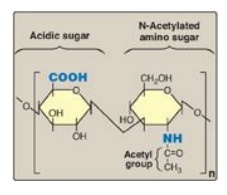Overview of Glycosaminoglycans
| Home | | Biochemistry |Chapter: Biochemistry : Glycosaminoglycans, Proteoglycans, and Glycoproteins
Glycosaminoglycans (GAGs) are large complexes of negatively charged heteropolysaccharide chains. They are generally associated with a small amount of protein (“core protein”), forming proteoglycans, which typically consist of up to 95% carbohydrate.
OVERVIEW OF GLYCOSAMINOGLYCANS
Glycosaminoglycans
(GAGs) are large complexes of negatively charged heteropolysaccharide chains.
They are generally associated with a small amount of protein (“core protein”),
forming proteoglycans, which typically consist of up to 95% carbohydrate.
[Note: This is in comparison to the glycoproteins, which consist primarily of
protein with a variable (but typically small) amount of carbohydrate.] GAGs
have the special ability to bind large amounts of water, thereby producing the
gel-like matrix that forms the basis of the body’s ground substance, which,
along with fibrous structural proteins such as collagen, elastin, and
fibrillin-1, and adhesive proteins such as fibronectin, make up the
extracellular matrix (ECM). The hydrated GAGs serve as a flexible support for
the ECM, interacting with the structural and adhesive proteins, and as a
molecular sieve, influencing movement of materials through the ECM. The
viscous, lubricating properties of mucous secretions also result from the
presence of GAGs, which led to the original naming of these compounds as
mucopolysaccharides.

Figure 14.1 Repeating disaccharide
unit.
Related Topics
